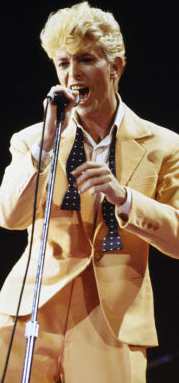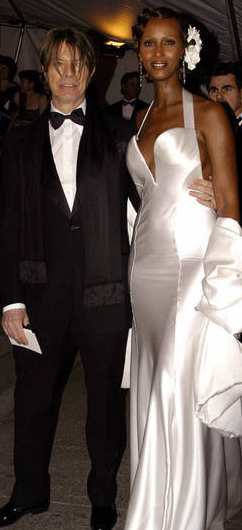the unveiling of
STARMAN: DAVID BOWIE

reviewed by
NICK CROWE
______________________
 When
I worked on a recording project with the music producer Tony
Visconti in the late 1990s, I was eager for stories about his
friend David Bowie. After all, Visconti had produced some of
his best works, including Young Americans and Scary Monsters.
“Bowie’s a cunt,” he said when the topic was
raised, as if it was common knowledge. The subject was never
discussed again.
When
I worked on a recording project with the music producer Tony
Visconti in the late 1990s, I was eager for stories about his
friend David Bowie. After all, Visconti had produced some of
his best works, including Young Americans and Scary Monsters.
“Bowie’s a cunt,” he said when the topic was
raised, as if it was common knowledge. The subject was never
discussed again.
Ground-breaking
pop star Bowie has been accused of many things during his career,
often for perfectly good reasons. Exploitation was a common
theme among fellow musicians, who felt used when he dropped
them after a session or tour, eager to move on. Tony Visconti’s
gripe was over credit -- recognition denied him and guitarist
Mick Ronson for their work on the 1970 breakthrough album The
Man Who Sold the World (a long time to hold a grudge, but they
have since made up).
Critics
and fans, bemused by the way Bowie so easily shrugged off one
stage persona for  another,
one style of music for another, frequently accused him of selling
out (something he would be guilty of in the 1980s) or worse,
plagiarism. Even his sexual ambiguity, immortalized by flamboyant
characters like Ziggy Stardust and Aladdin Sane, along with
his famously open marriage with Angela Barnett, were for some
an even more despicable ruse, dreamed up with his wife at their
flat in Haddon Hall to generate inches of newspaper coverage.
another,
one style of music for another, frequently accused him of selling
out (something he would be guilty of in the 1980s) or worse,
plagiarism. Even his sexual ambiguity, immortalized by flamboyant
characters like Ziggy Stardust and Aladdin Sane, along with
his famously open marriage with Angela Barnett, were for some
an even more despicable ruse, dreamed up with his wife at their
flat in Haddon Hall to generate inches of newspaper coverage.
Yet
Paul Trynka’s fascinating biography, Starman: David
Bowie -- The Definitive Biography,
does away with the ruthless, self-serving Bowie and reveals
instead a warmer, more instinctive figure, stripped of costume,
newsprint and celebrity veneer, whose relentless urge to create
was far more profound than merely a wish to control.
 In
musical terms, as Trynka rightly observes, Bowie’s achievements
are vast. By the release of Let’s Dance in 1983 he had
already made 16 studio albums, at least half of which, like
Hunky Dory, The Rise and Fall of Ziggy Stardust and Low, were
classics. No one since has come close. At the same time he influenced
records which not only saved the careers of his most beloved
role models, but became classics in their own right. Lou Reed’s
Transformer was one of these, which he produced, as was his
mix of Raw Power by Iggy Pop and the Stooges, an album which
would heavily influence punk. His stage acting, as in the 1980
production of The Elephant Man, was widely acclaimed for its
pathos, as was his role in the 1976 film The Man Who Fell to
Earth (his appearance in Absolute Beginners was not so fêted).
He pioneered the pop video (remember China Girl?), the stadium
tour, even contemporary advertising practice, some claiming
that his famous mutability was the precursor to brand ‘repositioning.’
That jealousy, perfidy and greed should attach themselves to
the foremost fashion and music icon of the 1970s is hardly a
wonder.
In
musical terms, as Trynka rightly observes, Bowie’s achievements
are vast. By the release of Let’s Dance in 1983 he had
already made 16 studio albums, at least half of which, like
Hunky Dory, The Rise and Fall of Ziggy Stardust and Low, were
classics. No one since has come close. At the same time he influenced
records which not only saved the careers of his most beloved
role models, but became classics in their own right. Lou Reed’s
Transformer was one of these, which he produced, as was his
mix of Raw Power by Iggy Pop and the Stooges, an album which
would heavily influence punk. His stage acting, as in the 1980
production of The Elephant Man, was widely acclaimed for its
pathos, as was his role in the 1976 film The Man Who Fell to
Earth (his appearance in Absolute Beginners was not so fêted).
He pioneered the pop video (remember China Girl?), the stadium
tour, even contemporary advertising practice, some claiming
that his famous mutability was the precursor to brand ‘repositioning.’
That jealousy, perfidy and greed should attach themselves to
the foremost fashion and music icon of the 1970s is hardly a
wonder.
Born
in bomb-damaged south London in 1947, David Jones attended school
in Bromley, and started up a band, influenced by the likes of
Lonnie Donegan’s skiffle and the outrageous Little Richard.
His father, Hayward Jones, encouraged his son’s musical
aspirations and bought him a saxophone when he was 13. But Bowie’s
musical talent was slow to develop, and his early attempts to
break into show business were met with disinterest and failure.
These years were crucial, says Trynka, in shaping Bowie’s
future. Struggling in anonymity made him absorb the concepts
being explored on the fringes of the art world.
He
also acquired a habit of interacting with cultural figures --
often on a whim -- which he never lost. In 1967 Bowie met avant-garde
mime artist Lindsay Kemp and took him on as mentor, touring
and performing with his decadent troupe. With Kemp he discovered
a theatre of identity, which would prove indispensable to his
later approach; it is this relationship between Bowie’s
experience and his music that drives Trynka’s narrative.
A stream
of concepts, personalities and events unfold with clarity and
speed, and reveal an excellent grasp of Bowie’s ever-changing
oeuvre. His encounters with Warhol and Lou Reed, his rivalry
and friendship with Marc Bolan, his adventures at the Sombrero
gay club, his shameless manager Tony Defries and his cocaine
addiction are absorbingly dealt with in this biography of one
of the first post-modern, post-sexual pop stars of our age;
an artist who was “free to play the role of man, woman,
or child.”
Starman
exhibits a huge passion for its subject, and rightly so. Bowie’s
legacy stretches way beyond the confines of music, into global
fashion, branding, sexual politics and art. Even now it gives
Lady Gaga permission to be outrageous, in clothing accessories
if not in music. But at ground level his influence may be more
pervasive -- sinister even. Trynka shines a light on Bowie’s
dark side, how his obsession with self-image and success cost
him family and friends. If narcissism is the prevailing inclination
of our age -- the vain pursuit of success through contrived
self-image -- then it may be Bowie that we have to thank.
This
review originally appeared in Prospect
and is published with permission of its editor.